Search Thermo Fisher Scientific
Invitrogen
CD284 (TLR4) Monoclonal Antibody (UT41), eBioscience™
FIGURE: 1 / 17
CD284 (TLR4) Antibody (14-9041-80) in ICC/IF, Flow
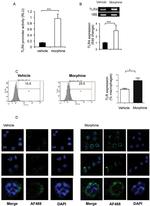
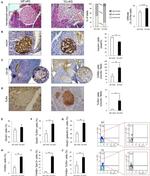
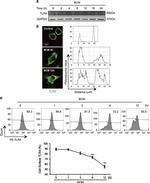
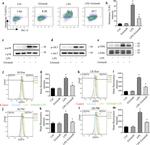

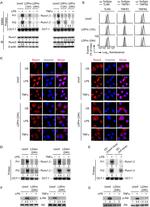
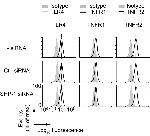
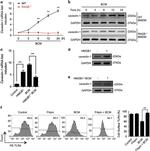
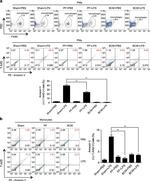
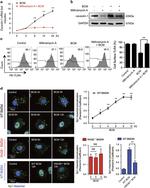
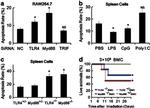
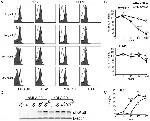
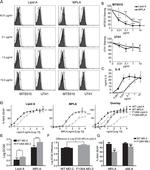
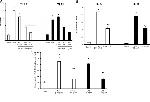
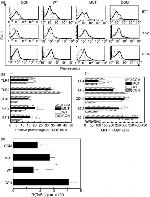
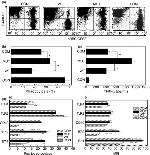

Product Details
14-9041-80
Species Reactivity
Published species
Host/Isotype
Class
Type
Clone
Conjugate
Form
Concentration
Purification
Storage buffer
Contains
Storage conditions
Shipping conditions
RRID
Product Specific Information
Description: The UT41 monoclonal antibody was generated against BaF3 cells overexpressing mouse TLR4. So far, at least twelve members of the Toll family have been identified. This family of type I transmembrane protein is characterized by an extracellular domain with leucine-rich repeats and a cytoplasmic domain with homology to the type I IL-1 receptor. Two of these receptors, TLR2 and TLR4, are pattern recognition receptors and signaling molecules in response to bacterial lipoproteins and have been implicated in innate immunity and inflammation. TLR4 physically associates with another molecule called MD-2, and together with CD14, this complex is responsible for LPS recognition and signaling. TLR4, which is approximately 100 kDa, is expressed by myeloid lineage cells.
The MTS510 monoclonal antibody co-immunoprecipitates MD-2 (~30 kDa) and TLR4 (~100 kDa), and preferentially reacts with TLR4 that is associated with MD-2. In comparison, binding of the UT41 monoclonal antibody occurs with and without formation of the TLR4/MD-2 complex. Please contact eBioscience Technical Support for further information.
Applications Reported: This UT41 antibody has been reported for use in flow cytometric analysis.
Applications Tested: This UT41 antibody has been tested by flow cytometric analysis of mouse thioglycolate-elicited peritoneal exudate cells. This can be used at less than or equal to 0.5 µg per test. A test is defined as the amount (µg) of antibody that will stain a cell sample in a final volume of 100 µL. Cell number should be determined empirically but can range from 10^5 to 10^8 cells/test. It is recommended that the antibody be carefully titrated for optimal performance in the assay of interest.
Purity: Greater than 90%, as determined by SDS-PAGE.
Aggregation: Less than 10%, as determined by HPLC.
Filtration: 0.2 µm post-manufacturing filtered.
Target Information
TLR4 is member of the Toll like receptor (TLR) family which plays a fundamental role in pathogen recognition and activation of innate immunity. TLRs are highly conserved from Drosophila to humans and share structural and functional similarities. This receptor is most abundantly expressed in placenta, and in myelomonocytic subpopulation of the leukocytes. Mammalian cells respond to LPS by activating TLR4. TLR4 belongs to the multi-protein complex of lipopolysaccharide (LPS) receptor, containing CD14, LY96 and TLR4, and is involved in signal transduction events induced by lipopolysaccharide (LPS) found in most gram-negative bacteria. TLR4 aids in the recognition of pathogen-associated molecular patterns (PAMPs) that are expressed on infectious agents, and mediate the production of cytokines necessary for the development of effective immunity. The various TLRs exhibit different patterns of expression. Mutations in the TLR4 gene have been associated with differences in LPS responsiveness. Also, several transcript variants of the TLR4 gene have been found, but the protein coding potential of most of them is uncertain. TLR4 is expressed by peripheral blood monocytes and a small population of B-cells and is also expressed in human placenta. Studies with TLR4-deficient mice indicate that the main ligand for TLR is lipopolysaccharide. Consequently, these mice also showed increased susceptibility to Gram-negative sepsis.
For Research Use Only. Not for use in diagnostic procedures. Not for resale without express authorization.
Bioinformatics
Protein Aliases: CD284; lipopolysaccharide response; Toll-like receptor 4
Gene Aliases: Lps; Ly87; Ran/M1; Rasl2-8; Tlr4
UniProt ID: (Mouse) Q9QUK6
Entrez Gene ID: (Mouse) 21898

Performance Guarantee
If an Invitrogen™ antibody doesn't perform as described on our website or datasheet,we'll replace the product at no cost to you, or provide you with a credit for a future purchase.*
Learn more
We're here to help
Get expert recommendations for common problems or connect directly with an on staff expert for technical assistance related to applications, equipment and general product use.
Contact tech support
